XAT Quantitative Ability And DI MCQ Quiz - 1 - CAT MCQ
29 Questions MCQ Test Mock Test Series for XAT - XAT Quantitative Ability And DI MCQ Quiz - 1
What is the minimum value of (48 cos x - 20 sin x)?
Group Question
Answer the following question based on the information given below.
The following pie-chart shows the sales and revenue collection for 5 different products produced in an electronic company. The cost incurred in producing a T.V., Fridge, Computer, D.V.D. and Micro-wave oven is Rs. 800, Rs. 950, Rs. 1350, Rs. 650 and Rs. 1300 per unit respectively.
Profit = Collection - Cost incurred Loss = Cost incurred - Collection

Q. What is the profit earned on one unit of Fridge?
Profit = Collection - Cost incurred Loss = Cost incurred - Collection

| 1 Crore+ students have signed up on EduRev. Have you? Download the App |
The following pie-chart shows the sales and revenue collection for 5 different products produced in an electronic company. The cost incurred in producing a T.V., Fridge, Computer, D.V.D. and Micro-wave oven is Rs. 800, Rs. 950, Rs. 1350, Rs. 650 and Rs. 1300 per unit respectively.
Profit = Collection - Cost incurred Loss = Cost incurred - Collection
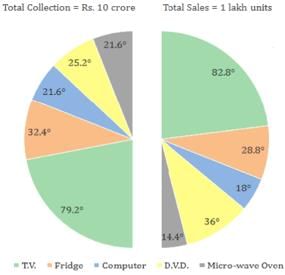
Q. What is the difference in the profit earned on Fridge and D.V.D. as a percentage of the profit earned on D.V.D.?
Profit = Collection - Cost incurred Loss = Cost incurred - Collection

The following pie-chart shows the sales and revenue collection for 5 different products produced in an electronic company. The cost incurred in producing a T.V., Fridge, Computer, D.V.D. and Micro-wave oven is Rs. 800, Rs. 950, Rs. 1350, Rs. 650 and Rs. 1300 per unit respectively.
Profit = Collection - Cost incurred Loss = Cost incurred - Collection
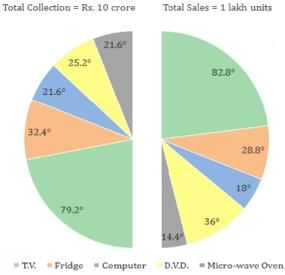
Q. What is the percentage profit earned by the company?
The following pie-chart shows the sales and revenue collection for 5 different products produced in an electronic company. The cost incurred in producing a T.V., Fridge, Computer, D.V.D. and Micro-wave oven is Rs. 800, Rs. 950, Rs. 1350, Rs. 650 and Rs. 1300 per unit respectively.
Profit = Collection - Cost incurred Loss = Cost incurred - Collection
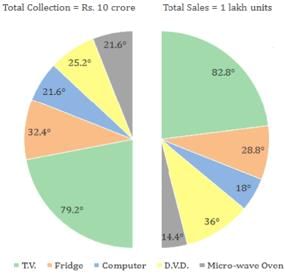
Q. If the income tax paid is [| profit/collection | * 100] %, then for which product will the company pay lowest income tax?
The following pie-chart shows the sales and revenue collection for 5 different products produced in an electronic company. The cost incurred in producing a T.V., Fridge, Computer, D.V.D. and Micro-wave oven is Rs. 800, Rs. 950, Rs. 1350, Rs. 650 and Rs. 1300 per unit respectively.
Profit = Collection - Cost incurred Loss = Cost incurred - Collection
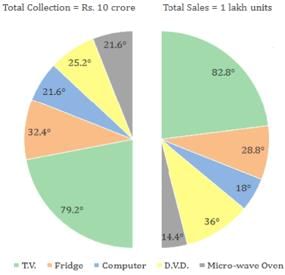
Q. What is the percentage share of Micro-wave ovens in the total profit earned by the company?
Group Question
Answer the following question based on the information given below.
A series of positive integers has the following terms: First term: 1; Second term: (2 + 3 + 4); Third term: (5 + 6 + 7 + 8 + 9); and so on.
Q. What is the last number in the nth term of the series?
A series of positive integers has the following terms: First term: 1; Second term: (2 + 3 + 4); Third term: (5 + 6 + 7 + 8 + 9); and so on.
Q. What is the sum of the numbers that form the nth term?
What is the total number of natural numbers N such that out of all the factors of N (except 1 and N) the largest factor is 21 times the smallest one?
A certain biased coin when tossed has a probability p of showing head. If the probability that there will be exactly one head in 5 tosses is same as the probability that there will be exactly two heads in 5 tosses, then what is the probability that there will be exactly 3 heads in 5 tosses?
Let a, b, c, d be positive real numbers and a + b + c + d=1. Then (1 - a)(1 - b)(1 - c)(1 - d) is always less than which of the following?
A picks a random integer between 1 and 1499, triples it and gives the result to B. Each time B gets a number from A, adds 100 to the number, and gives the result back to A, who triples the number again. The first person, whose result is more than 2000, loses the game. Let ‘x’ be the smallest initial number that results in a win for A. The sum of the digits of ‘x' is:
where n is a positive integer. Then for how many values of ‘n' is g(n) prime?
If, m = 2 x 4 x 6 x 8 x ... x 98 x 100. What is the total number of 0’s at the end of m?
Towns A and B are 200 km apart; A is in the South and B in the North. There is only one railway track between them; on a certain day, trains start simultaneously from both A and B with different speeds towards each other. The train starting from A has a speed of 40 km/hr. A fly is initially 80 km north of A. As soon as the trains start, it starts flying towards the train initially at B; on reaching it, it immediately turns around and starts flying towards the other train, and turns around again on reaching it. It continues this behaviour till the trains meet and it is squashed. At the time that the trains meet, the fly has flown equal distances North and South. What is the speed (in km/hr) of the second train?
Three packs of 52 playing cards are shuffled together. In how many ways can 26 cards from this stack be selected such that there is no duplicate card (in these 26 cards)? [Note: Duplicate card means a card of the same suit and same denomination.]
Triangle ABC is right angled at B. A perpendicular BD is drawn from B onto AC such that AD : DC = 1 : 4. If BD = 4 cm, what is the length of AC in cm?
A cow is tethered, using a rope of 20 ft, to a corner of a rectangular house which measures 16 ft by 10 ft, situated in the middle of a very big grass land. What is the maximum area that can be grazed by the cow?
Group Question
Answer the following question based on the information given below.
The questions are based on the following pie charts: Following pie charts give the details of the number of students in the age group of 25 to 27 years, pursuing different specializations in September 2007 and March 2008 at an MBA college. No student joined or left the college or made a shift to another specialization during this period.
Q. The minimum number of students who crossed the age of 27 between September 2007 and March 2008 is:
The questions are based on the following pie charts: Following pie charts give the details of the number of students in the age group of 25 to 27 years, pursuing different specializations in September 2007 and March 2008 at an MBA college. No student joined or left the college or made a shift to another specialization during this period.
Q. Which is the most popular specialization in the age group 24 years 6 months to 25 years in September 2007?
The questions are based on the following pie charts: Following pie charts give the details of the number of students in the age group of 25 to 27 years, pursuing different specializations in September 2007 and March 2008 at an MBA college. No student joined or left the college or made a shift to another specialization during this period.
Q. If the number of students aged 26 years 6 months to 27 years in September 2007, was the minimum possible, then which of the following statements is definitely true?
The questions are based on the following pie charts: Following pie charts give the details of the number of students in the age group of 25 to 27 years, pursuing different specializations in September 2007 and March 2008 at an MBA college. No student joined or left the college or made a shift to another specialization during this period.
Q. If the number of students who attained the age of 25 years between September 2007 and March 2008 and specialising in finance was the minimum possible, it was
The questions are based on the following pie charts: Following pie charts give the details of the number of students in the age group of 25 to 27 years, pursuing different specializations in September 2007 and March 2008 at an MBA college. No student joined or left the college or made a shift to another specialization during this period.
Q. If the number of students who crossed the age of 27 years between September 2007 and March 2008 and specialising in Marketing was more than in any other specialisations, what is the minimum number of students in that specialisation who crossed the age of 25 years between September 2007 and March 2008?
Group Question
Answer the following question based on the information given below.
The table given below shows the age-wise population distribution of India in 2010.
Q. In 2011, the population of only the age group 41 to 50 years increases, while population of other groups remains constant. If the population of the age group 41 to 50 years, in 2011, increases by 15% over that in 2010, then what is the ratio of the minimum percentage increase and maximum percentage increase in India’s total population?
The table given below shows the age-wise population distribution of India in 2010.
Q. Which of the following age-groups account for maximum population?
The table given below shows the age-wise population distribution of India in 2010.
Q. What is the difference between the population in the age- group of 15 - 20 years and 40 - 45 years assuming that 25 million people are in the age-group of 56 and above?
The table given below shows the age-wise population distribution of India in 2010.
Q. Which of the following represents the ratio of populations of the age-group of upto 30 years and age-group of above 55 years?
Each question is followed by two statements, A and B. Choose the most appropriate option given below.
What is the value of (x + y) if ( x - y ) 5?
A. 2x + 3y = 17
B. 2(x + 2) - 3(y - 2) = 31
Amar and Baron are given a six-shot pistol which has only one bullet in its cylinder. Both of them fire a shot one after the other.A shot can be a blank shot or a lethal shot. The one, who fires a lethal shot, is the winner. After each shot the cylinder of the pistol is shuffled so that the other person has a fair chance of firing a lethal shot. It is also known that Amar had the opportunity to fire the first shot. What is the probability that Baron wins the game?
|
16 docs|30 tests
|


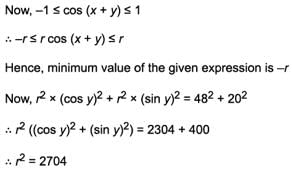

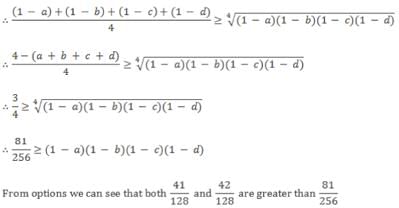
 3k2
3k2 















